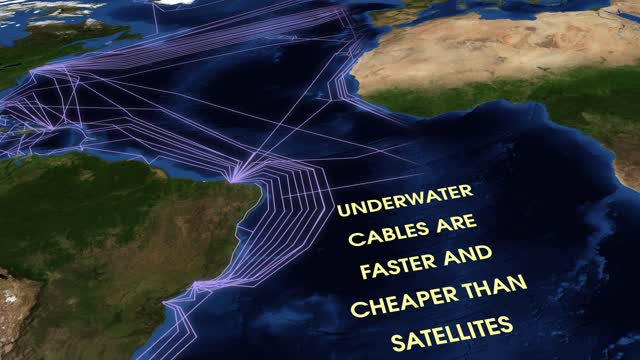Premium Only Content

Undersea Cables Wire Ends Of Earth To Power Internet
Every time you connect to the internet, there's a very good chance you're sending and receiving data through a network of cables that run along the bottom of the earth's oceans. The Internet is so fast and effortless to use. We often forget that a lot of it travels through underwater cables. Nearly 300 meters cable systems line the ocean floor, connecting the entire world together.
Since fiber-optic cables use light to encode information and remain unfettered by weather, cables carry data faster and cheaper than satellites - they carry 99% of all international data. They’re about as thick as a garden hose and carry the world’s internet, phone calls and even TV transmissions between continents at the speed of light. The fastest ones carry up to 60 terabits per second travelling at two-third the speed of light. That’s why every time you chat to someone overseas, it all happens almost instantly, which is pretty amazing, considering the first cable was laid over 150 years ago and took 17 hours to send a short telegraph. So, next time you are online remember some of that data is crossing oceans just for you.
The fact that we route internet traffic through the ocean - amidst deep sea creatures and hydrothermal vents - runs counter to most people’s imaginings of the internet. Didn’t we develop satellites and Wi-Fi to transmit signals through the air? Haven’t we moved to the cloud? Undersea cable systems sound like a thing of the past.
The reality is that the cloud is actually under the ocean. The cables are actually state-of-the-art global communications technologies. They crisscross the continents too - a message from New York to California also travels by fiber-optic cable. These systems are not going to be replaced by aerial communications anytime soon.
-
 1:05
1:05
IFLScience
7 years ago $0.01 earnedNASA's Tiny Robot
42 -
 0:24
0:24
Shtuff
4 years agoEnds of the earth
155 -
 11:29
11:29
Lynda Cromar Online Training
4 years agoPower Lead System How Internet Marketing Really Works
87 -
 0:49
0:49
Viral Tab News
5 years ago $0.11 earnedWoman Spots Snake Slithering Along Power Cables
493 -
 11:14
11:14
Joshranwest
4 years ago $0.65 earnedInternet 90s Style
7633 -
 15:18
15:18
Lynda Cromar Online Training
4 years agoPower Lead System For Our One Two Three of Internet Marketing For Anything
17 -
 0:34
0:34
KNXV
4 years agoExpanded internet access
258 -
 3:15
3:15
Fantomworld
4 years agoNaruto power
289 -
 LIVE
LIVE
The Official Steve Harvey
12 days ago $4.73 earned24 HOURS OF MOTIVATION w/ STEVE HARVEY
3,103 watching -
 25:56
25:56
DeVory Darkins
16 hours ago $0.09 earnedTrump drops ULTIMATE BOMB on Democrat Mayors as ICE makes SHOCKING Announcement
6.99K74